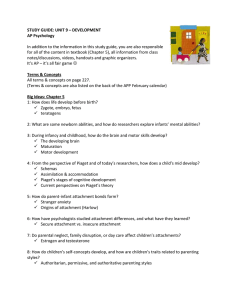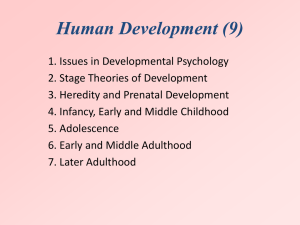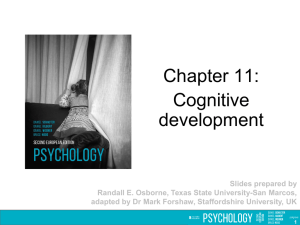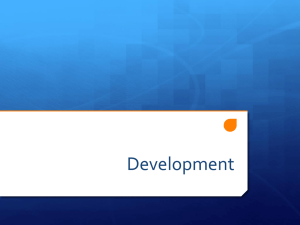GENERAL PSYCHOLOGY
advertisement
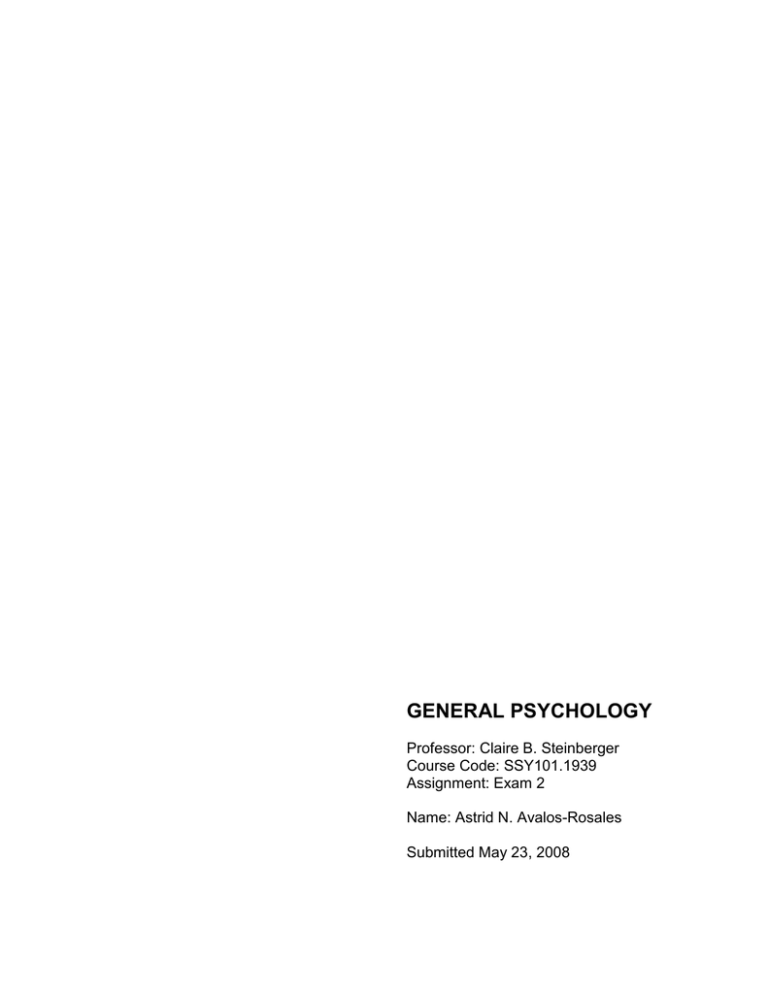
GENERAL PSYCHOLOGY Professor: Claire B. Steinberger Course Code: SSY101.1939 Assignment: Exam 2 Name: Astrid N. Avalos-Rosales Submitted May 23, 2008 I. Nature and Nurture Fraternal twins were separated at birth. Each child was adopted by different families. In elementary school the girl did best in art and music and the boy did well in math and sports. She was somewhat shy and he was very outgoing. The girl grew up to be and elementary school teacher and the boy became a lawyer. What could account for their differences and similarities? Genes would account for the similarities. Fraternal twins, who develop from separate eggs, would share some physical characteristics, as any other ordinarily brothers or sisters. In the other hand, environment influence would account for the differences. The experiences affect the brain development. Children placed in different environment would have different stimulus. Through their families, social relationships, and communities these children learn their own way to think and to act. They were confronted with different scenarios. They might share genes but their experiences formed them. II. Development 1. How do developmental areas interact throughout the life cycle? The developmental areas are: Physical Development: It starts the development of the brain, and nerve cells. In the Infancy and childhood, there is a motor development, in which children can perform tasks such as walk, or sit, and there is a maturation of the Infant memory. In the adolescence, it starts a process of sexual maturation. In the adulthood there are physical changes, such menopause in women and there is physical decline from middle adulthood. Cognitive Development: In the Infancy and childhood, mind develops forming schemas that help to assimilate experiences. In the adolescence, teens develop the capacity for formal operations which lead them to reason abstractly. Social Development: In the Infancy and childhood, attachment can predict the later social behavior and a self-concept starts to develop. In the adolescence, teens solidify their sense of self to form their own identity. In the adulthood, develop intimacy and a sense of contribution. Emotional Development: Though their life cycle, people experience felling of love, happiness, sadness, according to the events that they live. All the development areas work or interact together in the developing of a person. People cannot separate one from another because one influences the other ones. 2. Describe the cognitive approach of Piaget. The cognitive approach of Piaget is divided in four stages. The four stages are: Sensorimotor: This stage includes babies from birth to nearly two years. Piaget says that babies from this age range experience the world through senses and motor activities, for instance touching objects or looking at different shapes. In the sensimotor stage two phenomena are likely to happen. The first one is Object Permanence, in which babies develop the concept that things exist even when they do not perceive them. The second one is Strangers Anxiety, in which babies are not able to adjust to the people that do not know. Preoperational: This stage includes children between two and six years. In this stage, Piaget says that children are able to represent things with words and through images but they lack logical reasoning. This stage is characterized by three phenomena. The first one is that children pretend to play, in which the child develops imagination. The second one is Egocentrism, in which children do not see another’s point of view. The third one is Language Development, in which the child learns how to communicate throughout a language. Concrete Operational: This stage includes children between seven to eleven years. Piaget says that children from this age range think logically about concrete events, and that are able to understand analogies and perform mathematical operations. In this stage two phenomena are likely to happen. The first one is Conservation, that is the principle that properties such mass, volume, and number remain the same regardless changes in the form of objects. The second one is Mathematical Transformations, in which children can understand and perform mathematical operations. Formal operational: This stage includes children from 12 years and goes to adulthood. According to Piaget, in this stage humans are able to have an abstract reasoning. The phenomena in this stage are Abstract logic and Potential for mature moral reasoning. 3. Describe the Psychosocial model of Erik Erikson. The Psychosocial model of Erik Erikson is divided in eight stages. The stages are: Infancy: This stage includes children from birth to 1 year. If children needs are met, infants will develop a sense of basic Trust. In the other hand, if needs are not met, infant will develop a sense of Mistrust. Toddlerhood: This stage includes children from one to two years. Children learn to exercise will and do other things by themselves developing Autonomy, or they doubt of their abilities. Preschooler: This stage includes children from three to five years. Children learn to initiate tasks and carry out plans developing in this way Initiative, or they feel guilty about efforts to be independent. Elementary School: This stage includes children from 6 years to puberty. Children learn the pleasure to apply themselves to task developing the sense of Competence, or they feel inferior. Adolescence: This stage includes teenagers to people in their 20’s. Teenagers work in solidify a sense of self, integrating different roles to form a single identity, or they become confused about who they are. Young Adulthood: This stage includes people from their 20’s to early 40’s. Young adult’s task is to form close relationships and to gain the capacity for intimate love, or they would feel socially isolated. Middle Adulthood: This stage includes people from their 40’s to 60’s. Adults develop a sense of contribution to the world or they feel lack of purpose. Late Adulthood: This stage includes people from late 60’s to up. Older adult develop a sense of satisfaction or failure when reflecting on his or her own life. 4. How does research in human and animal attachment help psychologists? Research in human and animal attachment helps psychologists to understand how the social development of a person or animal occurs. Infants become attached with their parents because they fulfill their needs but also because their comfortable and familiar with them. When deprivation of attachment occur monkeys and humans may become anxious or even abusive. For example, the experiments that the psychologist Harry Harlow did with monkeys, showed that monkeys reared in total isolation that later are place with other monkeys from their same age, either get frightened or react aggressively. Most of them are incapable of mating as adults, and in the case of female monkey, when artificially impregnated, they become neglectful, abusive and in some cases murderous with their first born. In humans the same patron is shown. David Meyer says that “the unloved often become the unloving”. In other word most abusive parents report that they were neglected as children. Disruption of the attachment, also, can cause lasting damage. Studies show that after babies, humans or monkeys, are separated from their mothers they get upset an even despaired. 5. What are the challenges of people living longer lives in most Western societies? The challenges of people living longer lives in most Western societies are: To adapt at the decline of the physical abilities, for example visual sharpness diminishes, and adaptation to changes in light levels slows. To adapt at the decline of cognitive abilities that affects memory, creativity and intelligence. To achieve a sense on integrity, the feeling that one’s life has been meaningful and worthwhile. 6. If you were a Principle of an elementary school how would you apply cognitive and social theory to a sound educational program? I would create a program for children whom native language is not English to improve their abilities, vocabulary and skills in the language. The cognitive theory would be applied in the development of the language. Children would learn new words in English, and they would form new schemas or concepts to organize and to interpret the new information. After assimilate these new words they would be able to use them to accommodate new information. The social theory would be applied in the development of competence. Children would improve their skills in English, and they would become competent at the language. In this way they would avoid or overcome feelings of inferiority among their pairs. 7. Compare a child of elementary school age with one in Junior or High School. What are the cognitive, social and emotional expectations? What are the challenges of each stage? Elementary School vs. High School Child Cognitive Expectations: Elementary school children are expected to represent things with words and images, but they lack logical reasoning. They also are not able to see other’s point of view. In the other hand, high school teens are able to think logically about abstract events. Social and Emotional Expectations: Elementary school children are expected to deal with issues of competence. In other words, they learn how to overcome task, but if they are not able to do that they would have feelings of inferiority. In the other hand, high school teens are expected to deal with issues of identity. They would integrate different roles to form a single identity. If they are not able to do it they would be confused about who they are.
